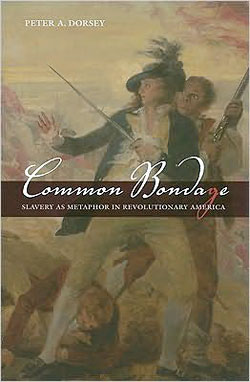Commonplace Conclusions on the Revolution and Bondage

“One need not delve far into the literature of the Revolution,” Peter Dorsey aptly observes, “to find that of all words, the one that most persistently, most contentiously, and most flexibly drove the era’s rhetorical engine was slavery” (xi). While this has long made the rhetoric of slavery a staple in a wide variety of historians’ analyses of the American Revolution, this is the first book-length treatment of the metaphorical usages of slavery and their impact on the Revolutionary era and beyond. “In the revolutionary era,” Dorsey contends, “language and the discursive process was itself an ‘actor’ in shaping and driving the conflict and fostering the emergence of antislavery thought” (xii). But the language of slavery cut many ways, he illustrates, so its impact was not simply antislavery; some of the ways in which Revolutionaries and their opponents employed the slavery metaphor actually supported rather than undercut the continuance of African-American bondage.
In largely chronological fashion and drawing on a wide array of primary sources, Dorsey walks the reader through the multifarious uses of the slavery metaphor across the broad sweep of the Revolutionary era, from patriot struggles in the 1760s through the drafting and ratification of the federal Constitution. Along the way, thematic chapters attend to the gendered implications of the slave metaphor; the Loyalists’ pointed responses to the Patriots’ introduction of the loaded metaphor to their already vicious ideological contest; the practical, mostly antislavery, impact of the Patriots’ need for ideological consistency once they decided to stubbornly persist in broadcasting the metaphor despite how easy it was for Loyalists to highlight their hypocrisy; and the complicating impact of anxieties about slave insurrection on both sides of the whites’ conflict. Dorsey, a literary critic, ventures occasional excursions into literary theory—such as a chapter centering on various “leading theories of metaphor” (19). But gratefully, he does not allow the narrative to bog down in theory, making it eminently readable.
There is very little with which to disagree in Dorsey’s analysis of the impact of slavery rhetoric. He is, to be sure, too apt to talk in overly sweeping terms: there is in this book not so much North and South but a nationwide, unitary “slave-holding culture” (xviii) that intensely localist contemporaries would not have recognized. But his overall points concerning the pervasiveness and complexity of that impact are well-taken. That complexity arose, as he demonstrates well, not only from the various ways in which debaters employed the metaphor, but also from the fact that revolutionaries’ commitment to universal liberty collided with their equally passionate commitment to property rights.
The problem with the book, in fact, is the exact opposite of a dubious or controversial thesis. It is that, disappointingly enough, this sustained attention to the rhetorical employment and practical influence of the slavery metaphor has almost nothing new to say. Granted, there are occasional glimpses of insight that may strike some scholars as interesting, including the notion that the slavery metaphor may have functioned as something of a shibboleth early on for the Patriot movement (4); or the point that “a central horror” in Patriot imaginations “was the idea that the bondage that threatened white Americans, like chattel slavery itself, was hereditary” (27). But for the most part, the glimmers of insight begin with promise but their punch lines end up being delivered by Dorsey drawing on another scholar (see e.g. 49-50). Chapters that seem promising proceed with a whimper rather than a bang. At the end of chapter 2, for instance, it seems that the theories of metaphor with which he engages add nothing to our understanding of the complicated effects of the slavery metaphor. And as this reader eagerly pursued chapter 3 and its analysis of gender and the slavery metaphor, the chapter induced a shrug rather than adding to existing knowledge. Even on the macro level, the book’s point about how the slavery metaphor cut in both antislavery and proslavery directions constitutes an extension of rather than even the slightest revision of a key 2003 article by Francois Furstenberg in the Journal of American History.
General readers unacquainted with the intersections of slavery and the American Revolution may well learn quite a bit from this book, then, but scholars of the era or of questions related to slavery and abolition will not. That seems an odd choice for a university press to publish.
